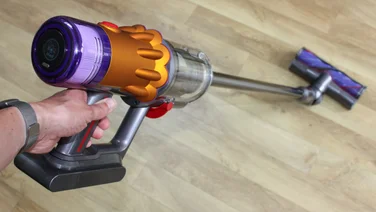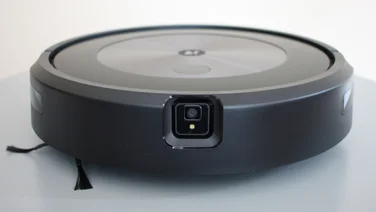To help us provide you with free impartial advice, we may earn a commission if you buy through links on our site. Learn more

Dyson vacuums can be working hard every day, collecting all the unwanted dust, dirt and bacteria from your floors, but a dirty filter can easily stop them from performing at their best. A clogged filter reduces suction, preventing your Dyson vacuum from picking up as much, but that’s not the only problem.
“If the Dyson filter is full of dirt and dust, then it can block air flow from getting round”, says cleaning and organisational expert Heidi Phillips. “This, in turn, can cause the motor to overheat, which can damage the vacuum and decrease life expectancy of the vacuum.”
How often should you wash your Dyson filter?
To keep your Dyson running smoothly, it’s wise to wash the filter on a regular basis. Heidi generally recommends a monthly wash, but the exact timing will depend on how much you use your machine.
“If you have used the vacuum more than usual, noticed the suction is not as good as usual or noticed a strange smell then you may need to do it sooner,” she says.
How to wash a Dyson filter correctly so as not to damage it
- Remove the filter: First, making sure that the vacuum is unplugged, detach the filter from your Dyson vacuum according to your model’s instructions. Refer to the user manual, if needed – if you can’t find it, the Dyson website has downloadable PDFs of the manuals for all of their models
- Tap away loose dust: Gently tap the filter against the inside of your bin to remove loose dust and debris
- Wash with warm (not hot) water: Rinse the filter under lukewarm water. It’s best to avoid using detergents as they can damage the filter
Heidi suggests lightly massaging the filter to work out any trapped dirt. “Vigorously cleaning the air flow pleats can lead to squashing or ripping them, which in turn stops the air flowing through properly”, she says. “The pleats need to be respected and gently patted.”
For filters that you can fill with water, do so, then cover the ends and shake to loosen the dirt before emptying it out. Repeat this procedure a couple of times.
- Shake and dry: Keep rinsing until the water runs clear, then shake out the excess. Leave the filter to air-dry in a well-ventilated, warm area.
“One of the biggest mistakes people make is not letting the filter dry completely before reinserting it”, says Katie Lilywhite, floorcare specialist at AO. “Filters need at least 24 hours to air-dry. A damp filter can lead to mould growth, blockages, and even motor damage.”
The benefits of washing filters
Regular washing of your Dyson filter will ensure stronger suction from your vacuum, and cleaner floors. Plus, a clean filter can help prevent unpleasant odours, both from lingering in your vacuum and from circulating around your home. And a clean filter also reduces the amount of allergens being blown back into your home. As Katie says: “A clean filter helps reduce allergens, as clogged filters can allow fine dust and pollen to recirculate into the air instead of trapping them.”
Plus, regular cleaning can also extend the filter’s lifespan, meaning you won’t have to replace it quite as often. Bear in mind that even washable filters have a limited life – Dyson recommends replacing the filter every 12 months, or if they start to show signs of wear.
If you vacuum daily, it might be worth considering getting a second filter to rotate to while the other one is drying.
How to wash filters from other brands
“Make sure to check your manual to understand where the vacuum filter is and see if it is washable”, advises Katie. “If it is, run under lukewarm water and allow to air-dry for at least 24 hours before putting it back into the appliance. If your vacuum filter is not washable, simply tap the filter against a hard surface to dislodge clumps of dust and lint.”
While the general principle behind washing the filter remains the same, regardless of the manufacturer, here’s a quick guide to some of the most popular vacuum cleaner brands:
Shark
Depending on what model you have, your vacuum cleaner may have a thick foam filter, plus one that’s made of felt, and a HEPA filter. It’s a good idea to check the instructions in your specific model’s user manual but, typically, these can be rinsed in lukewarm water and left to air-dry completely. Just don’t forget to tap off any extra dirt first.
Hoover
Hoover models can vary greatly – some may even have two filters – so check your manual first. For non-HEPA filters, Hoover recommends using warm soapy water to give them a proper wash. If it’s a HEPA filter, then tap it to get rid of the dust or rinse it under cold water. Always ensure the filter is completely dry before reinserting it.
Henry
The traditional Henry vacuums use a large, pleated filter that isn’t washable – just tap it to remove dust. Henry’s cordless stick models utilise special pods that act as filters, and these need replacing every three to four weeks.
Miele
Depending on the model, you may have a pre-filter and a fine dust filter that can be cleaned by tapping off the dust. Some bagless models also have two filters that can be rinsed under cold water. When in doubt, consult the user manual.
GTech
After removing the filter from the cover, tap both the filter and the cover over a bin to shake loose any dirt and debris, then wash the filter under a tap. GTech recommends using a water temperature no hotter than 40°C. Once the water runs clean, squeeze out any excess water and let it completely dry before reinserting.
Bosch
Depending on the model, some Bosch filters are recommended to be cleaned merely by tapping against the inside of the bin, while other filters can be cleaned with just water. Remember to let it dry at room temperature for at least 24 hours.
Roomba
Roomba’s filters are not designed to be washed, or even to come in contact with liquid. Instead, gently tap them against a bin to remove dust and debris.
By regularly giving your filter a quick but careful clean – and making sure it’s completely dry before using it again – you’ll keep your vacuum performing at its best for longer, no matter which brand you own.






